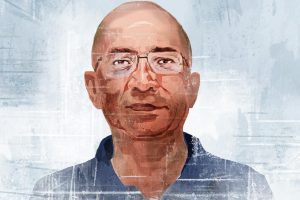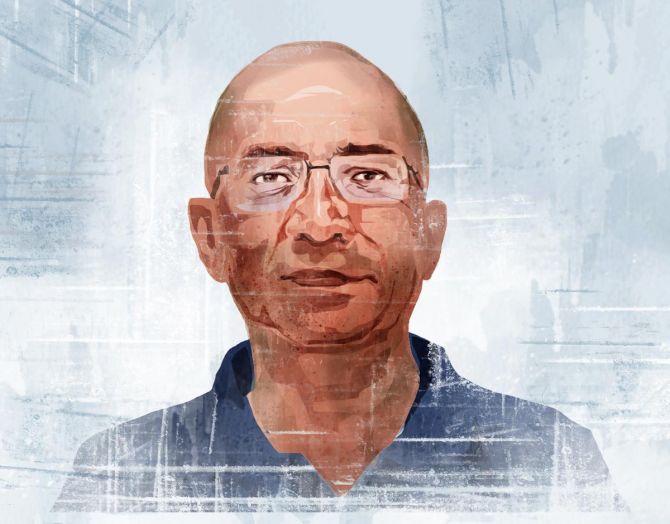Meet India’s Latest Billionaire

‘It has taken us 15 years to get to where we are. It obviously doesn’t happen overnight.’
Amongst all the unicorns that listed last year and had blockbuster, billion-dollar IPOs, the most low-profile, unrecognised and under-publicised would arguably be Venkat Viswanath and his wife Pramad Jandhyala’s Bengaluru-based LatentView Analytics.
If companies are anything like their founders, then Viswanath justifies that parallel, turning up in his everyman office shirt, khaki trousers and beat-up shoes.
There’s no sign of being a millionaire, much less an entrepreneur who’s worth hundreds of millions of dollars.
Viswanath is meeting me for lunch at the Four Seasons in Mumbai.
We are seated promptly in a quiet corner and agree to order ‘light’ vegetarian Chinese, which comprises stir-fried asparagus and broccoli, spinach noodles, sautéed eggplant and fresh lime sodas.
I can’t help but ask: Did being a billionaire, even if for only a short while, mean anything? It seems not.
Viswanath and Jandhyala, who own around two-thirds of the data analytics company, are grounded, to a fault.
He still drives a 10-year-old Honda City and she, a Hyundai i20.
What he doesn’t hold back on, however, are customer events, venues for which include the Museum of Modern Art (New York), the Loeb Boathouse in Central Park, the Four Seasons Hotel in San Francisco or a golf resort at Pebble Beach.
Does the recent crash in capital markets irk him?
“We are still well over twice the issue price, with a market cap of more than Rs 8,000 crore (Rs 80 million),” he declares, adding that LatentView was oversubscribed an unprecedented 338 times.
The record before that was 304 times for Paras Defence.
At least partially, not many knew of LatentView because its business is mostly B-2-B.
“Now, companies have a lot of data, right? And the ease with which you can store and access data has really gone up, right?”
Pointing to my phone, he says, “The amount of computing power in it is 100 times that of a computer 10 years back. But how are you going to use the data and how are you going to make better business decisions?”
That’s what LatentView does. Its customers include tech giants like Adobe, Uber and Microsoft.
The youngest of five children (he has four sisters), Viswanath, 51, says growing up he had the choice of engineering, medicine or chartered accountancy.
He chose engineering.
“I was never a brilliant student, but always maximised what I could achieve.”
That ability led him to the Indian Institute of Technology-Madras, also because he wanted to be as far away from his parents and have his independent space.
For the next four years he studied civil engineering, running with the best of the best.
“IIT is a tough place because we are so used to being the top of the class in our own small ponds, and here you find everyone is an alpha. Some are super-alpha. Like, in my dorm, the inventor of Google News was one batch ahead of me.
“As was the inventor of Google Finance, and somebody who worked for Microsoft’s latest technology,” he says.
“Initially, it’s a tough thing to handle for a young kid.”
It pushed him to set his bar higher.
After graduating, he joined the Essar Group in 1992 and was put in the chairman’s office, where he ended up assisting in the acquisitions of small businesses across the globe.
“Even though I was not trained for it, I started doing it. We bought some textile mills in Mauritius. And some machinery, incidentally from Odessa and Kyiv, and incorporated it into the Hazira plant (near Surat). These were plants that were getting mothballed. We bought them and repurposed them.”
Later, he joined the Indian Institute of Management-Calcutta and thereafter did a two-month internship with ITCin Kerala.
“Kochi was the number one branch for ITC in the country,” he says.
This done, he went right back to Essar, to the chairman’s office, in 1995.
But somewhere he felt the group was not on an upward trajectory and decided to look for a new gig.
At the time, he was living in Andheri East (north west Mumbai) near the train station, sharing a rental with two other bachelors.
His girlfriend (now wife; they married in 1997) from IIM lived in Bandra (also in north west Mumbai) and worked for Kotak Mahindra Bank at the time.
Our lunch has arrived, and we dig in.
“I got hired by ICRA (the credit rating agency),” Viswanath says, but after a couple of years, he jumped to technology and joined Cognizant.
At this point he moved to the UK, where he worked with clients across Europe, including Nokia, and made regular visits to Finland.
But in 2003, he returned to India with his wife.
Though still with Cognizant, he now intensely wanted to start something of his own.
He toyed with the idea of starting an auto components business, but abandoned it when he factored in the capital required.
As he pauses to dig into the broccoli, Viswanath says he took six months off to research the business possibilities and saw what a huge and growing area analytics was turning out to be.
And thus was born LatentView.
By 2010, LatentView started winning international customers, and in two quarters, went from 80 per cent of business coming from India to 95 per cent coming from the US.
“Today, two-thirds of our customer base is from Silicon Valley. And we have 15 per cent or so in retail. So again, the largest retailers in the US are our customers.”
Of LatentView’s 900 employees, 150 are in the US.
Does he get this pushback from promoters — that they know their business better than he does?
“Yes, I get to hear that, until they see the data, which is black and white, and then they sit up and say, ‘I never knew this about my business’.”
For one particular digital business, for instance, LatentView demonstrated that if customers did four transactions, they would stay on for life.
But if they did less than two, there was a high chance of losing them.
A left brain, right brain approach?
“That’s right,” says Viswanath. “We call it man plus machine. You need to have analysts of great quality who know how to interpret this data and more importantly, debate it and defend your judgement with the business leaders who may have a coloured view that’s not based on data.”
Is such a business profitable? “Very,” comes the answer.
“So much so that we bootstrapped our way all through the IPO.”
Of LatentView’s revenue of some Rs 360 crore (Rs 3.6 billion), profit margins are at 30 per cent, much more than some companies five times bigger.
We’re almost done with lunch and I can’t help but ask if he has used his market analytics on his own company to identify the gaps, and the rights and wrongs?
He smiles: “Not in the equities market, but as a business. For instance, we use data analytics and AI for hiring processes.”
In a world driven by instant gratification, does he have words of wisdom for young entrepreneurs?
“It has taken us 15 years to get to where we are. It obviously doesn’t happen overnight.”
Source: Read Full Article

